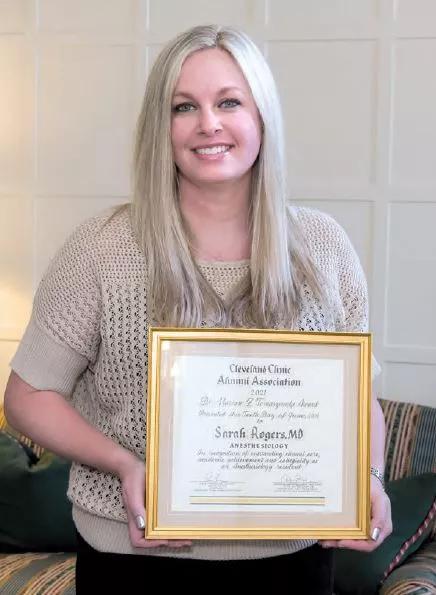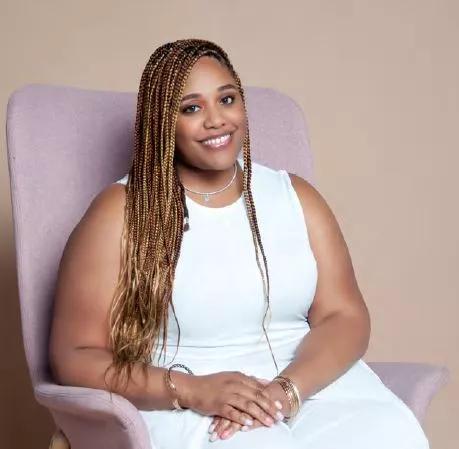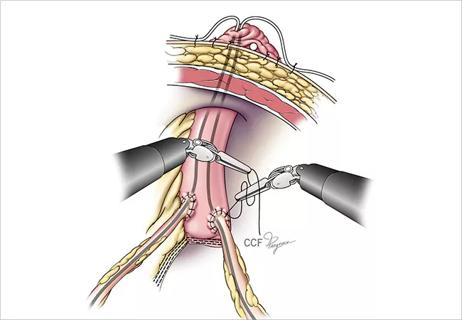Former Cleveland Clinic Nurse is First to Receive Dr. Tomaszewski Award
Advertisement
Cleveland Clinic is a non-profit academic medical center. Advertising on our site helps support our mission. We do not endorse non-Cleveland Clinic products or services. Policy

Cleveland Clinic anesthesiology resident Sarah Rogers, MD, says she is “humbled and honored” to be named the first recipient of the newly established Dr. Marian Z. Tomaszewski Award.
“I’m very passionate about pain management,” she says. “I hope to follow in Dr. Tomaszewski’s footsteps, and I know that I have some big shoes to fill!”
Created in memory of Dr. Tomaszewski (Staff’74) by his wife, Sylwia Gornik-Tomaszewski, PhD, and family, the award recognizes his significant contributions to Cleveland Clinic as a staff anesthesiologist from 1974 until his retirement in 1990. Dr. Tomaszewski, who died in 2018, developed the Section of Pain Medicine at Cleveland Clinic and is highly regarded as a clinical anesthesiologist and pioneer in the field of pain medicine. The annual award goes to a resident in their last year of training at Cleveland Clinic’s Anesthesiology Institute who has demonstrated outstanding clinical care, academic achievements and collegiality.
A career in nursing
Dr. Rogers’ most recent professional experience was as a registered nurse in Cleveland Clinic’s Emergency Department, from 2007 to 2017. She earned her medical degree at Northeast Ohio Medical University in 2017. Not only did she complete her studies on time while working at Cleveland Clinic, but when she started them, she was the mother of four children. By the time she graduated, she had six children, and soon thereafter, she gave birth to her seventh. She and her husband, Antowyone, have four boys and three girls, ages 19, 17, 14, 12, 6, 5 and 2.
Advertisement
Born and raised in Euclid, Ohio, Dr. Rogers fell in love with medicine as a child. Her grandparents were nurses in World War II, and she was especially influenced by her grandmother, she says. “I was 3 or 4 years old when I knew that I wanted to be a nurse. I just loved being a nurse at Cleveland Clinic, and I really wanted to keep learning more, to know what the doctors knew. I was drawn to anesthesia because the residents who came through the ER were always so nice. One day, an anesthesiologist came into our department with sticks of medicine in his pocket for a hypotensive patient who was going to the operating room. I didn’t know what the medicine was, and I really enjoyed learning about it. That’s when I realized that I wanted to know everything I could about this field.”
When she matched with Cleveland Clinic for her residency, Dr. Rogers was ecstatic. “It’s the only place I wanted to go. I matched there in March, when I was working in the Emergency Department as a nurse. I worked there until June, and by July 1, I started residency. I was a little worried about this change, but it was a completely seamless and amazing transition. I know the nurses, and we’re colleagues. I know they have a hard job, and I understand very well what it’s like, their frustrations and joys.” Pursuing pain management
While in her third year of residency, she was drawn to patients who were coping with pain. “I loved interacting with them, figuring out what they needed and how to help them. It started with one patient who had severe rheumatoid arthritis, and all she wanted was to be able to get up and sit at the table to eat dinner with her family. It hit such a chord with me. I loved talking with patients, getting to know their families. And whatever aspect of life it was they were trying to improve, I enjoyed finding out what was important to them and being able to make a difference.”
Advertisement
Dr. Rogers was applying for a pediatric anesthesiology fellowship when she met her patient with arthritis and decided to switch to pain management, instead. “I was at the right place at the right time,” she says. “I’m very thankful for that.”
In her personal life, she volunteers with nonprofit organizations that help people who need a home or are coping with addiction. “I was raised in a blue-collar household and worked very hard to earn everything I have,” she says. “I feel very blessed to be able to go to medical school and be a physician. I don’t take that lightly, and I feel it’s our duty to give back to people. When you’re a physician, it’s a calling. I also feel a kindred spirit – my brother died of a heroin overdose five years ago. I think it’s very important for us to look for ways to care for other people. That’s what I teach my children.”
She says her mentors at Cleveland Clinic include Julie Niezgoda, MD (Staff’95), a pediatric cardiology anesthesiologist who has guided her since medical school. “She is very caring and loves her patients. She is the anesthesiologist I always saw myself turning into,” Dr. Rogers says. Others are Teresa Dews, MD (AN’92), a pain management physician who is President of Cleveland Clinic Euclid Hospital; Dr. Rogers’ program director, Carlos Trombetta, MD (AN’09, ACTA’10); and her associate program director, Mariel Manlapaz, MD (AN’04,’06).
“Cleveland Clinic’s Anesthesiology residency program is the best training anywhere, with very high-complexity cases,” she says. “Our mentors are willing to assist and teach us. I don’t feel like I’m just a number. I love the program and feel so fortunate to be here.”
Advertisement
Dr. Rogers will start a pain management fellowship at Cleveland Clinic when she completes her residency. “I love Cleveland Clinic,” she says. “The care they give patients is truly world-class.”
GL-1 Award Recipient
Passionate About Education, Empowerment

Jamesha Ford, DO, a resident at Cleveland Clinic Akron General, is an entrepreneur and healthcare pioneer. Before her residency, she founded a company, Her Brand LLC, which she describes as “a platform and movement that helps to elevate and empower women through education, awareness, collaboration and connectedness.” She also helped start a nonprofit healthcare webinar series called “Generational Health” to provide patient education on chronic conditions that are common among African-American populations.
For these and other achievements, Dr. Ford was selected from among 14 nominees to receive the 2021 Alumni Association Graduate Level-One (GL1) Award, established in 1987 to recognize clinical excellence/knowledge, interpersonal communications skills, character and unique accomplishments.
“I am super excited and really grateful,” Dr. Ford says about receiving the award. She plans to use the $1,000 in award funds to advance her patient education and empowerment efforts.
The first in her immediate family to graduate from college, Dr. Ford says her curiosity originally drew her to chemical engineering. “I was good in math and science and thought that would be a good career,” she says. “During my freshman year in college, though, I was in a car accident and lost three of my fingers. Doctors were able to suture them back on, and that’s what initially got me interested in medicine.”
Advertisement
After graduating from college, a friend at Ohio University sparked her curiosity about osteopathic medicine. “I became interested in manipulative diagnostic treatment and helping the body to heal itself. Initially, I considered studying women’s health, but after an OB rotation, I became more interested in healthcare disparities and community maternity/mortality rates, realizing that many of these disparities start before conception.”
In the last year, Dr. Ford says, her family has experienced five deaths, mostly due to heart conditions. Two relatives who passed away were still in their 30s. This compelled her to find a way to educate the African-American community on preventable disease. “It was a very tough year for our family, and four out of these five deaths could have been prevented,” she says. “It was really tough to wrap my head around that. I decided to start an educational series, with the mindset that when you know better, you do better. Alongside the many factors contributing to healthcare disparities, such as implicit bias and mistrust of the medical community, lack of knowledge also plays a critical role, as well. My role in the Generational Health Series is to educate the community in a language they understand, to warn them about various symptoms to look out for.” She collaborates with some of her medical school colleagues in presenting a lecture series that draws on real-life cases “to shine a light on different disease states in efforts of bridging the healthcare gap and decreasing the incidence of disease.”
Dr. Ford credits a few mentors with inspiring and supporting her along the way. One is a family friend and primary care physician in her hometown of Cincinnati, Alaba D. Robinson, MD. Another is family medicine physician Katherine Sheridan, MD, her advisor at Cleveland Clinic Akron General. “She’s extremely supportive, especially last year when I was having a hard time,” she says. “Dr. Sheridan pushes me out of my comfort zone, and that’s what I need. If I paint the vision in my head, she provides the canvas.”
Dr. Ford plans to pursue a career in family medicine. “I love how diverse it is and being provided the opportunity to address different aspects of life during the family medicine visit. I’m also interested in psychiatry within family medicine. I ultimately want to do outpatient care and incorporate osteopathic manipulative treatment and integrative medicine.”

Robbie Zimbroff, MD, (PGY-2 IM), the 2021 Dr. William and Roxanna Michener Grant Award recipient, came to medicine via American history and the civil rights move¬ment. He was completing a master’s degree in historical studies in his home state of California when he learned that the Icahn School of Medicine at Mount Sinai New York was recruiting students from other disciplines for its medical humanities program.
By then, he was ready for a change. “I had spent summers in rural Mississippi in library archives and talking to civil rights veterans, trying to understand the legacy of Freedom Summer 1964 and the murders of three civil rights workers,” he says. “I was lucky to be doing research with a professor who spent lots of time with me, spon¬sored my research and let me assist him with his research. I loved the process and the stories of those who participated and seeing how these fit into the larger story.”
He also learned that he enjoyed these interviews far more than the time he spent in libraries. “Ultimate¬ly, it can be a very isolating voca¬tion,” he says. “I wasn’t cut out for it. My favorite part was talking with people who were in the civil rights movement, and my favorite part of medicine is talking with patients.”
Each year, the Dr. William and Roxanna Michener Grant Award goes to an individual whose peers and teachers identify their true leadership qualities. Awardees also must demonstrate a commitment to learning, superior communication abilities, and a mastery of medical skills, as well as embody the courage, integrity, and compassion that represent the highest ideals of clinical medicine. The honoree receives $3,000 to assist with developing a project to enhance their leadership and/or humanitarian activities.
Dr. Zimbroff is developing a humanistic, post-acute care model for patients with serious illness. “This builds off the work of many others in the Cleveland Clinic Accountable Care Organization, to whom I am deeply indebted,” he says. “I want to meet patients’ unmet needs when they return home, as opposed to going to a skilled care facility. The funds will be used to conduct a needs assess¬ment to understand how to help better serve patients at home.”
Over the last century, he says, more people have lived longer and healthier lives thanks to medical advances. “Yet, such progress begs challenging questions: ‘Have all people benefitted from these advances? Does prolonging life always enhance quality of life? How could the system better serve patients and their doctors?’ My answers are found in the interplay between the scientific and humanis¬tic investigation of disease and health.”
His mentors include chief resident Ken Koncilja, MD (IM’16), “a very generous mentor in whose footsteps I am trying to follow,” Jessica Hohman, MD, MSc, a primary care physician, research mentor and advisor who is “absolutely brilliant and who helps me think through problems,” and Robert Mayock, MD (Staff’97), an internal medicine physician, “the absolute model of a clinician-servant, a most caring, dedicated doctor who has a medi¬cine residency teaching award named after him,” he says. “I am drawn toward all of them because their consideration of the humanistic side of medicine is very evident in the way they practice.”
Dr. Zimbroff plans to pursue a career in geriatric medicine and is especially focused on “person-centered care.” He says that he wants to learn how to help patients remain independent, at home and living their lives the way they wish to live them.
Dr. Zimbroff says he is honored to receive the Michener Award. “This award is an incredibly gracious memorial to a physician’s life. It’s humbling to know that Dr. Michener was so dedicated to compassion, empathy and the intersection of the humanities and medicine. I’m deeply grateful to him, his family and all the mentors along the way who have made my education possible.”
Advertisement

Manoj Monga, MD, assesses urology's opportunities and challenges

Study shows surgical experience impacts the risk of post-operative stricture formation

Study offers evidence to guide treatment decisions

Assessments of the shorter collection routine are encouraging, but not yet definitive